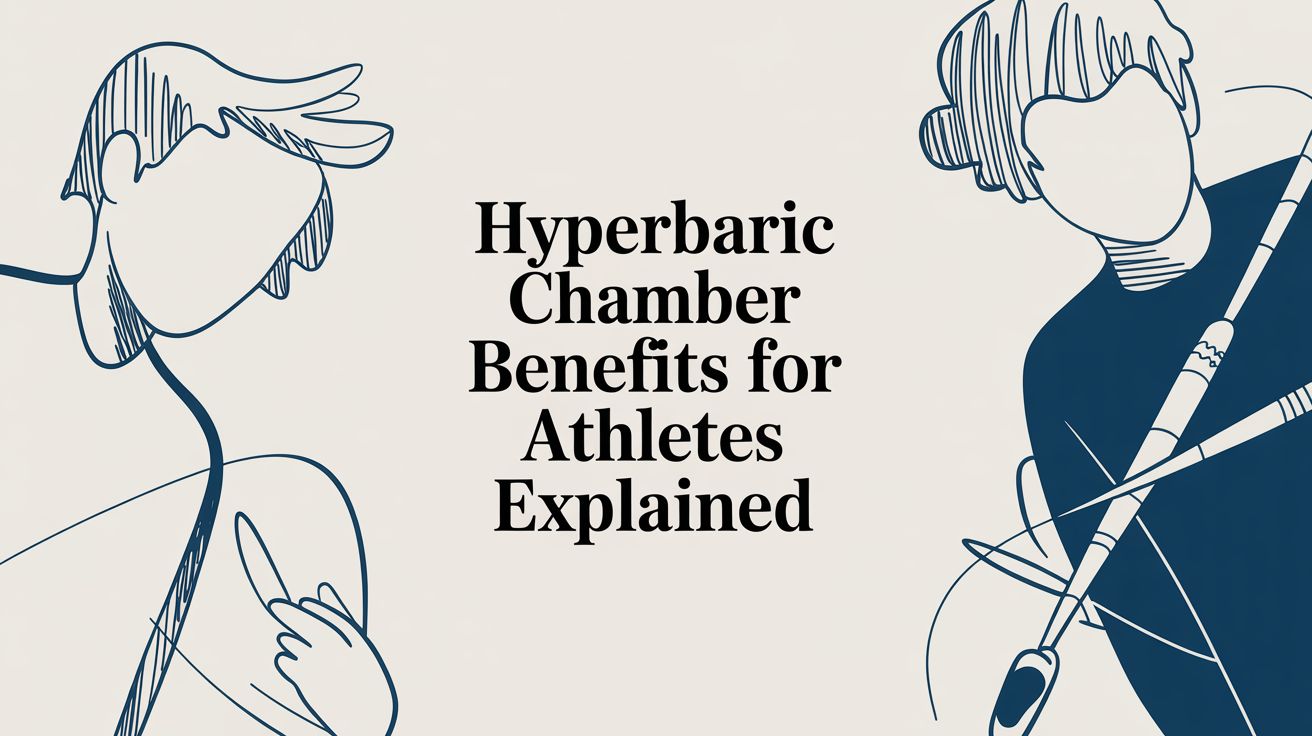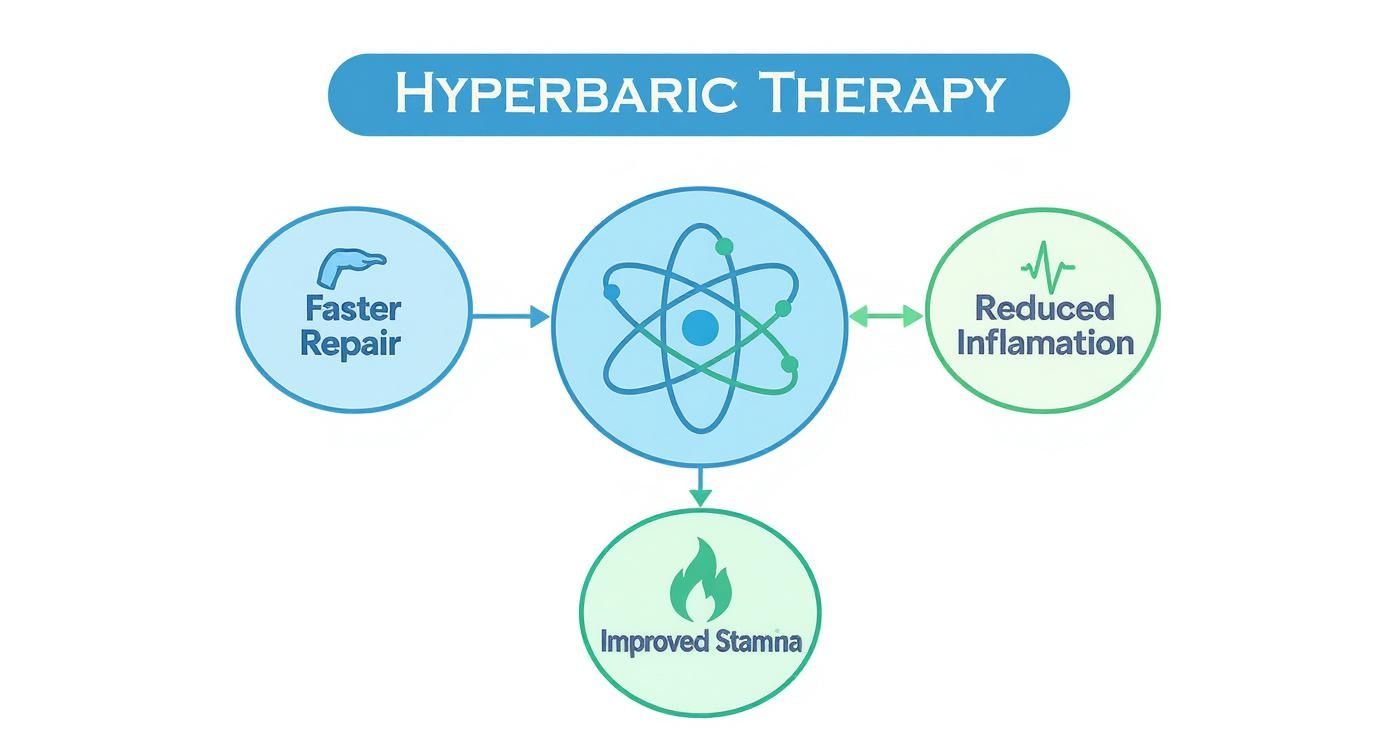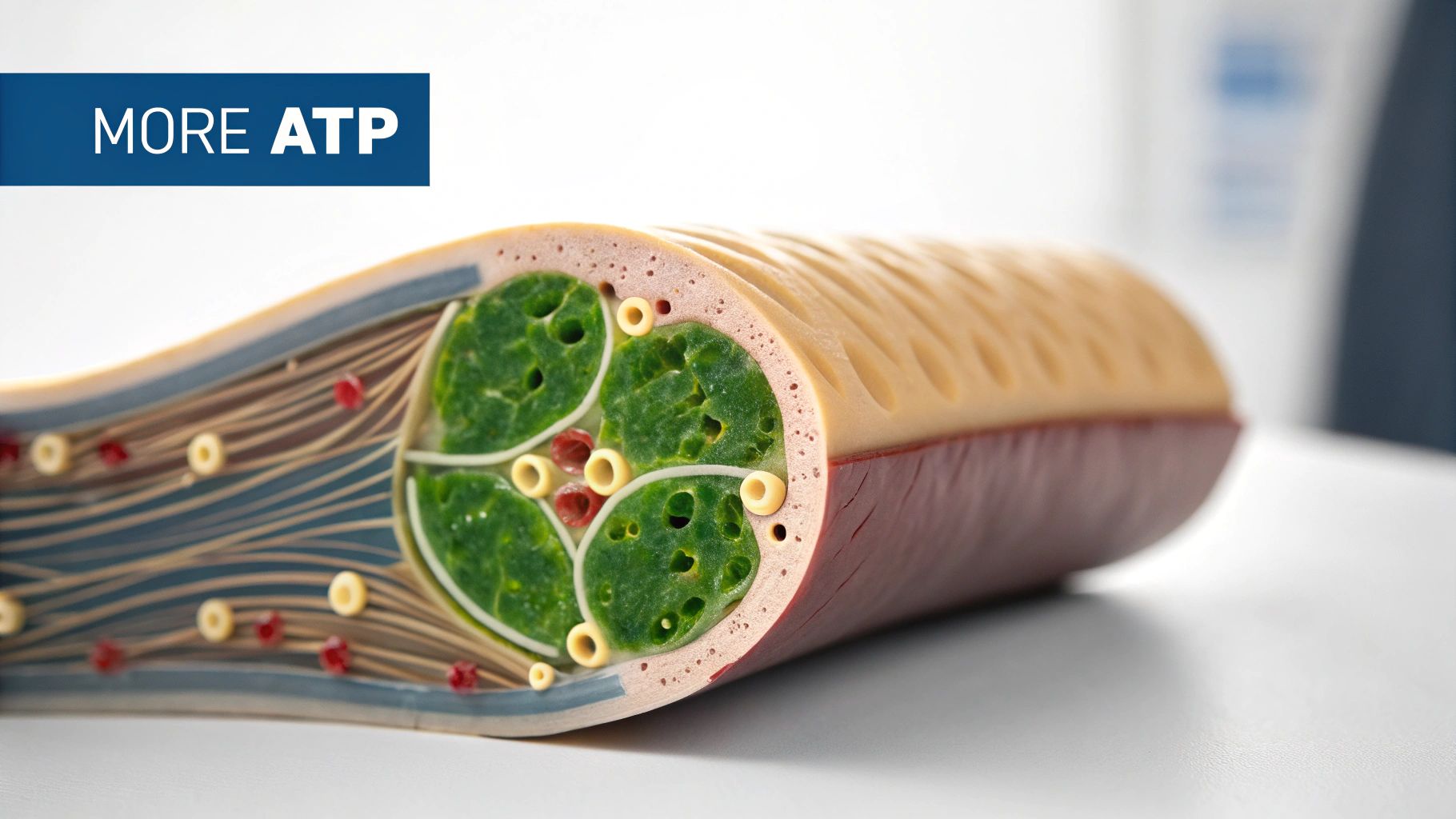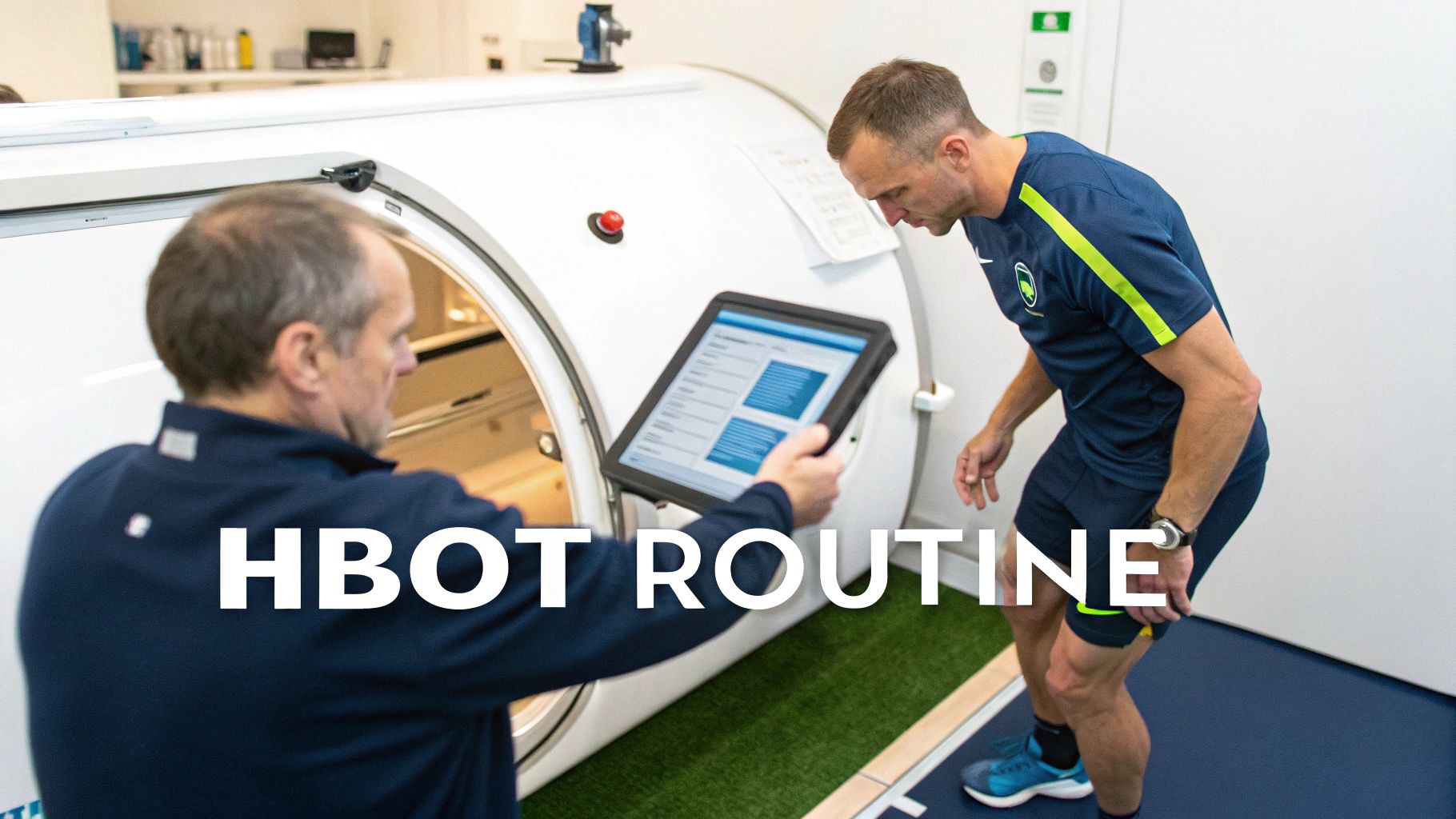
Hyperbaric Chamber Benefits for Athletes Explained
Hyperbaric chamber benefits for athletes are centered on several key wellness principles: accelerated tissue repair, reduced inflammation, and improved physical resilience. The therapy works by having you breathe concentrated oxygen in a pressurized environment. This process allows your body’s tissues to absorb significantly more oxygen, enhancing natural healing and wellness processes to support your athletic endeavors.
The Wellness Edge of Hyperbaric Oxygen Therapy
For any athlete, achieving peak performance is intrinsically linked to effective recovery and overall well-being. Intense physical activity creates microscopic tears in muscle fibers and triggers an inflammatory response. While this is a natural part of building strength, managing the recovery process is crucial for sustainable health and consistent training.
This is where Hyperbaric Oxygen Therapy (HBOT) offers a significant wellness advantage.
Imagine your body's cells as engines requiring fuel to function. After strenuous exercise, these engines need oxygen to repair and refuel, but the circulatory system has limits on how quickly it can deliver it. HBOT acts as a wellness catalyst. By increasing the ambient pressure, it dissolves a high volume of oxygen directly into the blood plasma and other bodily fluids, overcoming typical delivery constraints. This oxygen-rich environment promotes healing from the inside out.
Real-World Health Gains from Enhanced Oxygenation
These benefits are not just theoretical; they translate into tangible improvements in an athlete's health and ability to perform. By supporting the body's innate repair mechanisms, HBOT allows athletes to train effectively while minimizing the risks of overtraining and burnout.
HBOT fundamentally enhances the recovery equation. It provides an abundance of the most critical element for tissue repair—oxygen. This enables the body to bypass normal circulatory limitations, delivering healing resources directly to tissues that need them most after being pushed to their limits.
Instead of being sidelined by prolonged soreness, athletes using HBOT often report feeling fresher and more prepared for subsequent training. This is not just about comfort; it's about fostering a sustainable cycle of training and recovery. The ability to consistently perform at your best supports long-term improvements in strength, endurance, and overall wellness. It's a strategy for building a resilient foundation for athletic longevity.
To put it simply, here’s a quick look at how HBOT supports peak wellness and performance.
Key HBOT Benefits for Athletic Health at a Glance
This table outlines the primary physiological advantages that hyperbaric oxygen therapy provides to athletes, connecting the science to concrete health outcomes.
| Benefit Category | Physiological Impact | Wellness Outcome |
|---|---|---|
| Accelerated Recovery | Reduces muscle soreness by helping to clear metabolic byproducts like lactic acid more efficiently. | Less downtime between training sessions, promoting more consistent and healthy training cycles. |
| Reduced Inflammation | Helps constrict blood vessels to decrease swelling and modulates inflammatory responses. | Faster healing from physical stress and a reduced risk of chronic overuse injuries. |
| Enhanced Stamina | Increases oxygen saturation in tissues, improving mitochondrial energy production for better cellular health. | Greater endurance and the ability to sustain peak effort with less physiological strain. |
Ultimately, these benefits work synergistically to help create a more resilient, healthy, and consistent athlete.
How Hyperbaric Therapy Unlocks Your Body's Potential
To truly understand why hyperbaric chambers are a valuable wellness tool for athletes, it is essential to look at the physiological mechanisms. At its core, Hyperbaric Oxygen Therapy (HBOT) is a straightforward concept. It utilizes increased pressure and concentrated oxygen to fundamentally enhance how the body heals and performs. Think of it as a way to deeply saturate your entire system with the element most vital for energy and repair.
Here’s a simple analogy. Imagine trying to dissolve sugar in a glass of water. Eventually, you reach a saturation point. However, if you could increase the pressure within that glass, you could force much more sugar to dissolve. A hyperbaric chamber does exactly this for your body with oxygen.
The Science of Super-Saturation
This process is governed by a fundamental law of physics known as Henry's Law. It states that the amount of gas that can dissolve in a liquid is directly proportional to the pressure of that gas. Inside a hyperbaric chamber, the increased atmospheric pressure allows your lungs to absorb far more oxygen than is possible at normal, sea-level pressure.
Normally, oxygen is transported primarily by red blood cells. HBOT introduces a new delivery method. The high pressure forces oxygen to dissolve directly into all of your body's fluids—including blood plasma, lymph, and the cerebrospinal fluid surrounding your brain and spinal cord.
This means oxygen-rich plasma can travel freely, independent of red blood cells, reaching deep into tissues, joints, and other areas where blood flow might be compromised due to injury or inflammation.
This process essentially creates an oxygen superhighway throughout your body. It bypasses typical circulatory bottlenecks to ensure every cell receives the high-quality fuel it needs to recover and rebuild—especially those in strained muscles, bruised ligaments, or fatigued tissues.
This infographic breaks down how hyperbaric therapy fosters benefits like faster repair, reduced inflammation, and better stamina by unlocking your body's natural wellness potential.

As you can see, the core mechanism—saturating the body with oxygen—is what directly fuels the health and wellness outcomes athletes seek for both peak performance and career longevity.
Understanding Pressure and Chamber Types
Not all hyperbaric sessions are the same, and the differences are important for athletes. The pressure inside a chamber is measured in atmospheres absolute (ATA). For reference, 1 ATA is the normal pressure we experience at sea level.
Hyperbaric chambers generally come in two main types, each offering different levels of pressure and, consequently, different potential outcomes:
- Soft-Shell Chambers: Often called "mild" hyperbaric chambers, these inflatable units typically reach pressures of 1.3 to 1.5 ATA. They are popular for home use and general wellness, contributing to relaxation and mild inflammation reduction.
- Hard-Shell Chambers: These are medical-grade units capable of reaching much higher pressures, often 2.0 ATA and above. This type of chamber is used in most clinical studies demonstrating significant benefits for physical performance and injury recovery.
The higher pressure in a hard-shell chamber allows for a greater degree of oxygen saturation, which is necessary to stimulate the profound physiological changes that accelerate healing and enhance endurance. This level of recovery support is sought after by elite athletes aiming to reduce downtime. Research on exercise-induced muscle damage has shown that athletes treated with HBOT recovered significantly faster, as the dissolved oxygen could reach fatigued tissues more efficiently. To learn more about this, you can read about how HBOT helps athletes recover on Hyperbaric Medical Solutions.
Boosting Endurance and Aerobic Capacity
Every athlete focused on endurance understands the concept of a performance ceiling. This limit is almost always defined by the body's efficiency in taking in, transporting, and utilizing oxygen.
Hyperbaric oxygen therapy is a powerful modality for helping to raise that ceiling.
Think of your cardiovascular system as a delivery network. Red blood cells are the carriers, and oxygen is the essential package. Under normal conditions, this network has a finite capacity. HBOT enhances this system by dissolving high concentrations of oxygen directly into the blood plasma, allowing for the transport of far more of this vital fuel than red blood cells can carry alone.
This state of hyper-oxygenation has a profound impact on aerobic performance. When every muscle fiber receives an abundant supply of oxygen, the body becomes more efficient at producing energy. This translates directly into greater stamina and the ability to sustain a higher work rate for longer periods.
Upgrading Your Body’s Engine
An athlete's endurance capacity is often measured by two key metrics: VO2 max and the anaerobic threshold. These represent the peak efficiency of your body's energy systems and how long you can sustain high-intensity effort. HBOT has shown a remarkable ability to positively influence both.
- VO2 Max (Maximal Oxygen Consumption): This is the maximum amount of oxygen your body can utilize during intense exercise. A higher VO2 max indicates a more efficient aerobic system, allowing you to run faster, cycle harder, or swim longer.
- Anaerobic Threshold: This is the point at which your body produces lactic acid faster than it can clear it, leading to muscle fatigue. Pushing this threshold higher means you can maintain a high-intensity pace for a longer duration before fatigue accumulates.
By delivering more oxygen to the mitochondria—your cellular power plants—HBOT helps delay the onset of lactic acid buildup. When muscles have more oxygen available, they can rely on efficient aerobic energy production for longer, preserving anaerobic reserves for critical moments like a final sprint.
This isn't just a temporary boost. Consistent HBOT sessions can stimulate lasting physiological adaptations, essentially training your body to become a more efficient oxygen-processing machine. It is akin to upgrading your car's engine for greater power and efficiency.
Clinical Evidence for Enhanced Performance
The connection between hyperbaric oxygen and aerobic capacity is supported by scientific research.
A key blinded, randomized controlled trial demonstrated significant improvements in the maximal oxygen consumption of middle-aged athletes. In this study of 31 healthy master athletes, the group receiving genuine HBOT sessions experienced a statistically significant increase in their VO2 Max compared to the control group. Furthermore, their oxygen consumption at the anaerobic threshold also improved, indicating a dual benefit for both peak power and sustained endurance. You can find more details on how HBOT improves cardiovascular resistance on Hyperbarium.
Translating Lab Metrics to Real-World Wellness
For an athlete, these scientific improvements have tangible, real-world consequences. A higher VO2 max and a delayed anaerobic threshold can mean holding a faster marathon pace with less strain, maintaining pressure on an opponent in the final quarter, or completing a demanding workout without excessive fatigue.
Ultimately, boosting endurance is about performing stronger and healthier for the entire duration of an event. By optimizing the body’s ability to use oxygen, hyperbaric therapy provides a powerful tool for pushing past previous limits and achieving a new level of cardiovascular wellness and performance.
Fueling Performance at the Cellular Level

While building endurance is a significant health benefit, the true power of hyperbaric oxygen therapy occurs at a microscopic level. To fully appreciate how HBOT helps build a more resilient and healthy athlete, we must look beyond muscles and the heart to the cellular engines that power every movement.
These engines are your mitochondria, often referred to as the "power plants" of our cells.
Inside every muscle cell are thousands of these mitochondria, constantly working to convert oxygen and nutrients into adenosine triphosphate (ATP), the universal energy currency of the body. ATP is the raw fuel for every muscle contraction, every burst of speed, and all sustained stamina. The more efficiently your mitochondria produce ATP, the more energy you have available.
Supercharging Your Cellular Power Plants
Under normal conditions, oxygen delivery to these cellular power plants can be a limiting factor. During intense exercise, muscles demand more ATP than mitochondria can produce with the available oxygen, forcing the body to switch to less efficient energy pathways, which leads to fatigue.
Hyperbaric oxygen therapy changes this dynamic. By flooding the blood plasma with dissolved oxygen, HBOT delivers a super-saturated fuel supply directly to the cells. This massive oxygen surplus supercharges the mitochondria, enabling them to produce ATP at a much higher rate.
Think of your mitochondria as high-performance engines that typically run on standard fuel. HBOT is like providing them with pure, high-octane racing fuel, allowing them to operate at their peak potential. The result is more available energy, less fatigue, and a higher capacity for intense work.
Enhancing mitochondrial function is one of the most well-documented hyperbaric chamber benefits for athletes. Studies confirm that HBOT not only improves mitochondrial respiration but can also increase mitochondrial mass, effectively building more power plants within your cells. For athletes, this means a profoundly improved capacity for energy production and a reduction in the oxidative stress that can hinder performance. You can read the full research about how HBOT boosts mitochondrial function in athletes from PMC.
Building a Better Circulatory Network
The benefits extend beyond immediate energy. Consistent HBOT sessions also stimulate a powerful long-term adaptation called angiogenesis, which is the body's process of creating new blood vessels.
When tissues are repeatedly exposed to these high-oxygen environments, the body responds by building a more intricate and robust network of capillaries. This is not a temporary effect; it is a permanent structural enhancement to your circulatory system.
A denser capillary network offers several key advantages for athletes' health:
- Sustained Oxygen Delivery: More pathways mean oxygen and nutrients can reach working muscles more efficiently, even during prolonged efforts.
- Improved Waste Removal: This enhanced network is also more effective at clearing metabolic byproducts like lactic acid, which helps delay muscle fatigue and reduce soreness.
- Accelerated Healing: In the event of an injury, a richer blood supply ensures that damaged tissues receive the resources they need for rapid repair.
This combination of immediate cellular energy and long-term circulatory improvements is a cornerstone of athletic wellness and longevity. By optimizing your body from the cellular level up, you are not just preparing for the next competition; you are building a foundation for sustainable peak performance. To better understand the underlying science, check out our article on Hyperbaric Oxygen Therapy The Science of Recovery and Longevity. This process is key to ensuring your muscles get a continuous supply of fuel, which directly translates to greater work capacity and a more resilient career.
Integrating HBOT into Your Training Regimen

Understanding the science behind HBOT is one thing; learning how to integrate it into a demanding training schedule is another. The key is to use HBOT as a strategic wellness tool that complements your existing plan.
Success depends on finding the right combination of pressure, session duration, and frequency. This is not a one-size-fits-all approach. Your protocol should adapt based on whether you are preparing for a competition, recovering from a strenuous event, or healing from an injury. This is how you can unlock the maximum hyperbaric chamber benefits for athletes without disrupting your training rhythm.
Common Protocols for Athletic Goals
While every athlete's needs are unique, some well-established protocols can serve as an excellent starting point for a discussion with your coach or healthcare provider. They illustrate how HBOT can be adapted to the various demands of a competitive season.
- Pre-Competition Priming: In the days leading up to a major event, the goal is to optimize cellular energy reserves. Athletes often use HBOT to ensure they arrive fully recovered and prepared. This typically involves 3-5 sessions per week to thoroughly saturate tissues with oxygen.
- Post-Event Recovery: After pushing your body to its limits, the focus shifts to managing inflammation and promoting rapid repair. A short, intensive block of daily sessions for a few days can significantly reduce muscle soreness and support the body's natural recovery processes.
- Injury Rehabilitation: When dealing with an injury, the approach is often more intensive to accelerate healing. Daily sessions may be recommended initially to reduce swelling and deliver oxygen to damaged tissues to support rebuilding.
The core principle is strategic application. Just as you would tailor your workouts for strength versus endurance, your HBOT protocol should reflect your immediate physiological needs and long-term wellness goals.
The table below provides a snapshot of what these parameters might look like. Remember, these are guidelines, and professional guidance is essential to create a plan that is both safe and effective for you.
Sample HBOT Protocols for Different Athletic Goals
Here’s a guideline illustrating how HBOT session parameters can be adjusted based on an athlete's specific objective. These are examples and should always be customized with professional guidance.
| Athletic Goal | Typical Pressure (ATA) | Session Duration (Minutes) | Recommended Frequency |
|---|---|---|---|
| Performance Enhancement | 1.5 - 2.0 | 60 - 90 | 3-5 times per week |
| Post-Competition Recovery | 2.0 | 90 | Daily for 3-5 days |
| Acute Injury Management | 2.0 - 2.4 | 90 | 1-2 times daily initially |
| General Wellness | 1.3 - 1.5 | 60 | 2-3 times per week |
For those interested in incorporating this technology into their home or clinical setting, the next step is to explore the available equipment. You can find a range of models by checking out different hyperbaric chambers designed specifically for wellness and athletic recovery.
What to Expect During Your First Session
Your first experience in a hyperbaric chamber might feel unfamiliar, but the session itself is typically calm and relaxing. Knowing what to expect can help demystify the process, allowing you to focus on the wellness benefits.
As the chamber is slowly pressurized, you will feel a sensation of fullness in your ears, similar to what you experience during an airplane's descent or when diving in a deep pool. This is completely normal. The operator will guide you on how to equalize the pressure by yawning, swallowing, or gently pinching your nose and blowing.
Once the target pressure is reached, the sensation in your ears will disappear. For the remainder of the 60 to 90-minute session, you can simply relax. Many athletes use this time to listen to music, meditate, or rest, turning it into a valuable opportunity for mental and physical recuperation.
Safety Guidelines and Important Considerations
As compelling as the performance and recovery benefits of HBOT are, safety is always the top priority. Like any powerful wellness tool, understanding the guidelines is crucial to maximizing its benefits. Adhering to proper protocols ensures that each session is a positive step forward, free from unnecessary risks. When administered correctly, the therapy is remarkably safe, but being aware of key considerations is non-negotiable for any serious athlete.
Before beginning an HBOT protocol, a thorough consultation with a qualified healthcare professional is essential. They will review your medical history to ensure you are a suitable candidate. This is a critical safety measure designed to protect your well-being.
Conditions Requiring Caution
Certain medical conditions, known as contraindications, can make HBOT unsafe. It is vital to be completely transparent about your health history, as some conditions can be exacerbated by changes in air pressure.
Key contraindications include:
- Untreated Pneumothorax: A collapsed lung is an absolute contraindication, as the pressure changes in the chamber can be life-threatening.
- Recent Ear or Chest Surgery: These areas are sensitive to pressure shifts post-operation and require adequate healing time before undergoing HBOT.
- Certain Medications: Some drugs, particularly certain chemotherapy agents, may interact negatively with high oxygen concentrations.
Think of a pre-session screening like a pilot's pre-flight check. It is a systematic process designed to identify and address any potential issues beforehand, ensuring a smooth and safe experience.
Managing Common Side Effects
Most side effects associated with HBOT are minor, temporary, and easily managed. The most common issue is ear discomfort, or barotrauma, caused by pressure changes during compression and decompression. This is the same sensation experienced during an airplane takeoff or landing.
Simple techniques like swallowing, yawning, or the Valsalva maneuver (pinching your nose and gently blowing) can equalize the pressure and alleviate discomfort. Chamber operators are trained to manage the pressurization rate to allow for comfortable adjustment. Other less common effects, such as temporary vision changes or fatigue, typically resolve on their own shortly after the session. Knowing what to expect can help you approach the therapy with confidence. For those considering home wellness solutions, models like the UDR S200 Seated Hyperbaric Chamber are designed with user comfort and safety in mind, but professional guidance remains essential.
Common Questions Athletes Ask About HBOT
Even when the science is clear, practical questions are often what matter most. How does this fit into a training plan? Is it permissible in competitive sports? Let's address some of the most common questions from athletes and coaches about hyperbaric oxygen therapy.
How Soon After an Injury Can I Start HBOT?
For acute injuries like sprains or muscle tears, HBOT can often begin within 24-48 hours. Early intervention can help manage the initial wave of swelling and inflammation, providing the damaged tissue with the oxygen needed to initiate the repair process.
However, every injury is unique. The most important first step is to obtain a proper diagnosis from a physician. It is best to work with a professional who understands both your specific injury and hyperbaric medicine to determine the safest and most effective time to begin therapy.
Is HBOT Banned or Considered Doping in Sports?
No. Hyperbaric Oxygen Therapy is not on the prohibited list for the World Anti-Doping Agency (WADA) or other major sports organizations. It is considered a natural recovery modality, similar to physical therapy or ice baths.
Think of it this way: HBOT enhances the body's natural healing systems using a natural element—oxygen. It is a supportive therapy, not a prohibited performance-enhancing substance.
Are the At-Home Soft-Shell Chambers as Good as Hard-Shell Ones?
This is an important distinction, particularly for athletes seeking significant clinical results. Inflatable, soft-shell chambers used for home wellness provide "mild" hyperbaric therapy (mHBOT). They operate at lower pressures, typically around 1.3-1.5 ATA, and use an oxygen concentrator rather than 100% pure oxygen.
While these chambers can be beneficial for general wellness, relaxation, and mild inflammation, they do not produce the same physiological effects as medical-grade units. The powerful clinical results reported in studies—such as major boosts in VO2 max, enhanced mitochondrial function, and accelerated healing of significant injuries—are almost exclusively from research using hard-shell chambers. These systems can achieve higher pressures (2.0 ATA and above) and use 100% medical-grade oxygen, which is necessary to drive deeper physiological changes.
Ultimately, the right choice depends on your specific health and wellness goals.
Ready to unlock your peak performance potential? The science-backed wellness and recovery equipment at MedEq Fitness can help you bridge the gap between exertion and renewal. Explore our collection of professional-grade hyperbaric chambers and elevate your recovery game today. Visit MedEq Fitness to learn more.


